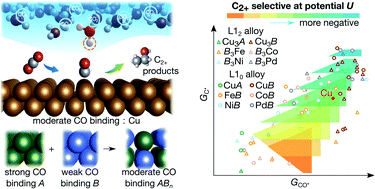Screening binary alloys for electrochemical CO2 reduction towards multi-carbon products†
Abstract
Electrochemical reduction of CO2 (eCO2R) to high-value chemicals presents an attractive approach for utilizing CO2. Copper (Cu) is presently the only electrocatalyst that fulfills this purpose with notable activity, but selectivity remains a problem. To identify catalysts for eCO2R with high selectivity towards multicarbon (C2(+)) products, we explore binary systems composed of strongly and weakly CO binding metals alloyed with Cu, Fe, Co, Ni, and Pd. A total number of 142 alloys with two commonly studied configurations, L12 and L10, are simulated with density functional theory (DFT). We leverage recent progress in the atomistic understanding of the eCO2R mechanism and use the binding energies of CO* and C* as descriptors when screening for C2(+) selectivity. We evaluate the stability of the binary alloys by analyzing the formation energy of the clean alloy surfaces. Our theoretical screening identifies about 16 Cu-based alloys and 18 non-Cu based alloys with optimal C2(+) selective properties for eCO2R. For the non-Cu based binary alloys, the p-block elements play an important role in tuning the C* and CO* adsorption energies. In terms of stability, most of the Cu-based systems alloyed with metals that exhibit strong CO* binding are unstable. Ni-based alloys are more stable than the Co-based alloys followed by the Fe-based alloys, and all the Pd-based alloys are stable. In general, the L10 structural Fe, Co, Ni, and Pd-based alloys are more stable than the corresponding L12 alloys. Our approach identifies materials known to have good C2(+) selectivity, but it also proposes several other promising materials that have not previously been tested for eCO2R.



 Please wait while we load your content...
Please wait while we load your content...
